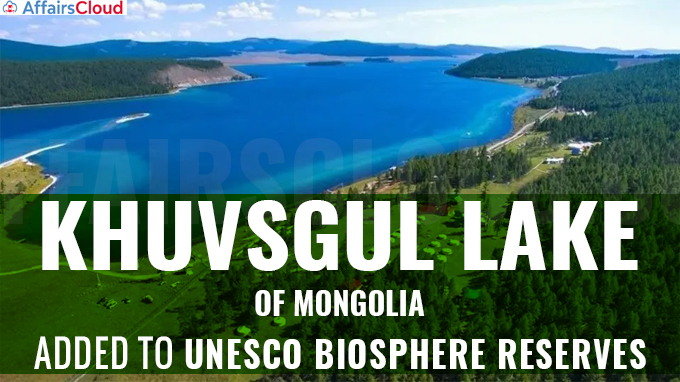
The 34th session of the International Co-ordinating Council (ICC) of the Man and the Biosphere (MAB) Programme of the UNESCO held at UNESCO headquarters in Paris, France from 13th to 17th June 2022 approved to add 11 new biosphere reserves in 9 countries to the United Nations Educational, Scientific And Cultural Organization (UNESCO) World Network of Biosphere Reserves.
- The council has also extended 2 existing biosphere reserves in Spain: El Hierro Biosphere Reserve and Sierra del Rincón Biosphere Reserve.
- Including the 11 new sites, there are 738 biosphere reserves in 134 countries, including 22 transboundary sites.
The 11 new biosphere reserves:
- Australia – Sunshine Coast Biosphere
- Cameroon – Doumba-Rey
- Chad – Sena Oura
- Georgia – Dedoplistskaro and Three Alazani Rivers
- Kazakhstan – Markakol Biosphere Reserve and Burabay
- Mongolia – Khuvsgul Lake
- Saudi Arabia – Harrat Uwayrid
- Zambia – Kafue Flats
- Zimbabwe- Chimanimani
Note: Chad, Georgia and Zambia are the three new countries added to the UNESCO World Network of Biosphere Reserves.
Sunshine Coast Biosphere Reserve (Australia):
Sunshine Coast, Located in Southeast Queensland, features a picturesque coastline, dunes, beaches, extensive waterways, wetlands and a range of mountains in the hinterland.
Doumba-Rey Biosphere Reserve (Cameroon):
The proposed site, located in the transition area between savannahs and forests, covers the Mbéré Valley, a remarkable site for bird conservation with more than 100 species identified in recent inventories.
This is the 4th biosphere reserve in the west-central African country.
Sena Oura Biosphere Reserve (Chad):
This is the first biosphere reserve in Chad.
It covers the total surface of 173,520 ha of the last untouched remnants of the Sudanian savannah in Chad.
Dedoplistskaro Biosphere Reserve (Georgia)
Dedoplistskaro is characterized by remote, large and sparsely populated areas around the Takhti-Tepha mud-volcano close to the border with Azerbaijan.
This is one of the two first biosphere reserves in Georgia.
Three Alazani Rivers Biosphere Reserve (Georgia)
The proposed site encompasses the catchment areas of the Alazani River and its two tributaries, containing a mosaic of alpine and floodplain forests, as well as alpine meadows
The site is located in the north-eastern part of Georgia in the eastern Caucasus.
The total area of the proposed Three Alazani Rivers Biosphere Reserve is 199 944 Hectare(ha).
Burabay Biosphere Reserve (Kazakhstan)
The site is located in the most elevated part of the (Kokshetau Upland) of the northern outskirts of the Central Kazakh Uplands (melkosopochnik). Burabay is well known for its many lakes. 14 of these lakes cover a combined surface area of more than 100 km2.
Markakol Biosphere Reserve (Kazakhstan)
Markakol Biosphere Reserve belongs to the Kurchum District of the East Kazakhstan Region, located in the southern Altai near the national border between Kazakhstan and China.
The site covers the anthropogenically disturbed natural complexes and ecosystems of the southern part of the Western Altai.
Khuvsgul Lake Biosphere Reserve (Mongolia)
The Khuvsgul Lake, located in Khuvsgul Province of Mongolia near the Russian borders, is the largest freshwater lake in Mongolia. This holds around 70% of Mongolia’s fresh water and 0.4% of the world’s fresh water. The lake is 1645 meters above sea level, 136 The proposed site is located in between the Sayan Mountains(north); Khangai Mountain ranges(south), Tuva Mountains(west) and Baikal Mountain Range (east).
The site encompasses the lake, its basin, the headwaters of Eg and Uur rivers, and the eastern Sayan watershed.
This is the Mongolia’s 9th site added to the World Network of Biosphere Reserves.
Harrat Uwayrid Biosphere Reserve (Saudi Arabia):
The site is located in the central and north-western part of the AlUla’ Mohafazat (county), a hot desert biome located in the Middle-East and Western Asia biogeographic region.
It is the second biosphere reserve in Saudi Arabia to get this recognition next only to Juzur Farasan Biosphere Reserve, which was recognized as UNESCO biosphere reserve in 2021.
Kafue Flats Biosphere Reserve (Zambia)
The proposed site, Kafue Flats Biosphere Reserve which is also a Ramsar site and an Important Bird Area, includes parts of the Lochinvar and Blue Lagoon National Parks.
This is the first biosphere reserve in Zambia.
Chimanimani Biosphere reserve (Zimbabwe)
The proposed site includes the Chimanimani National Park and comprises a mosaic of mountains, forests, grasslands and shrubs, along with freshwater ecosystems.
This is the 2nd biosphere reserve in Zimbabwe.
About Man and the Biosphere (MAB) Programme:
Man and the Biosphere Programme (MAB), launched in 1971, is an Intergovernmental Scientific Programme.
Aim: To establish a scientific basis for the improvement of relationships between people and their environments.
- The International Coordinating Council (ICC) of the MAB Programme is the main governing body of MAB.
- It consists of 34 members stated elected by the biennial General Conference of the UNESCO.
Click here for the complete list of UNESCO World Network of Biosphere Reserves




